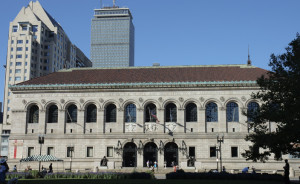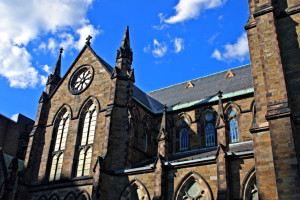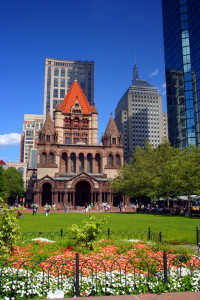Yesterday I took an easygoing walk in the Back Bay area of Boston. The relaxed pace was well worth it. I was able to take the time to notice the spectacular contrasts of Boston architectural styles that stand right next to each other. Throughout each neighborhood, the buildings work together to form a unique, scenic, and cohesive artistic backdrop to the city.
 I stopped in front of the Boston Public Library—an impressive Beaux Arts style building that opened in 1895. It’s a massive and grand symmetrical structure constructed with grey stone, slightly overscaled details, bold sculptural supporting consoles, rich deep cornices, sculptural enrichments, and elaborate ornamentation.
I stopped in front of the Boston Public Library—an impressive Beaux Arts style building that opened in 1895. It’s a massive and grand symmetrical structure constructed with grey stone, slightly overscaled details, bold sculptural supporting consoles, rich deep cornices, sculptural enrichments, and elaborate ornamentation.
 As I turned away, the Old South Church, which was completed in 1873, came into view. Its tall bell tower, multicolored stonework, decorative carvings, and roof covered in bands of red and dark gray slate show off its Gothic Revival architectural style. It stands elegantly in relationship to the massive grey stone library building.
As I turned away, the Old South Church, which was completed in 1873, came into view. Its tall bell tower, multicolored stonework, decorative carvings, and roof covered in bands of red and dark gray slate show off its Gothic Revival architectural style. It stands elegantly in relationship to the massive grey stone library building.

With my back now to the library, I became aware of the building directly in front of me—Trinity Church. This building, which was completed in 1877, is a National Historic Landmark. It’s the birthplace and archetype of Richardsonian Romanesque style. With the use of several colors, its clay roof, rough stone, heavy arches, and a massive tower, it claims its place as the anchor to the plaza.
Finally off to the right is the Hancock Tower—a tall, skinny glass minimalist, modernist skyscraper that opened in 1976. Its striking blue reflective glass draws your eye 790 feet up into the sky.
These architecturally significant individual buildings are surrounded by Victorian brownstones, and wide, parallel, tree-lined streets. It’s easy to see why the Back Bay area is often said to be one of the best-preserved examples of 19th-century urban design in the United States.
Strength lies in differences, not in similarities.
~ Stephen R. Covey
Throughout Boston, buildings stand right next to one another like this—constructed in many different ways over a period of more than three centuries. Each building is of a very distinct architectural style, but somehow they fit together and complement each other. It’s a beautiful mix of old and new—of different thoughts, styles, patterns, and philosophies—all blending, working, and living together effectively.
Architecture is influenced by our environment and our society—this is true in all the arts. The obvious differences are the elements each art form uses and the organization and function used to represent the experience. When you think about it, there are different interpretations of the experiences we all encounter in our lives, whether in the current time or one that has past. When these different philosophies and ways of thinking can coexist respectfully and contribute meaningfully to the whole, we can live more consciously and with the awareness of an artist. We can use our individual understandings of things to appreciate different belief patterns and strengthen our experiences of each other and the world around us.
All fine architectural values are human values, else not valuable.
~ Frank Lloyd Wright
Sign-up for the Arts Awareness eNewsletter and receive a free gift “Three Lessons to Begin to Make Artistic Principles Work for You in Fascinating Ways.” Like Arts Awareness on facebook.
